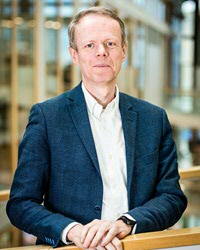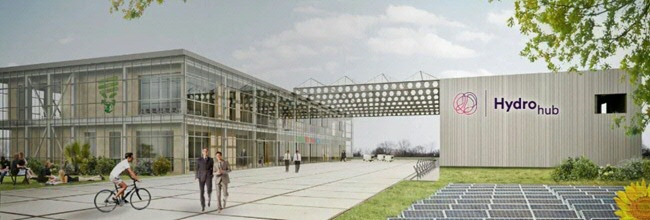Groene waterstof: onmisbaar en samenbindend
Samen onderzoek doen naar de productie van groene waterstof: waar de een, Paolo Pescarmona, aan de RUG belangrijke laboratoriumkennis vergaart, leidt de ander, alumnus Jan-jaap Aué, aan de Hanzehogeschool een project om kennis op te schalen naar een industrieel bruikbaar proces. Het is een van de projecten waaraan noordelijke kennisinstellingen samenwerken binnen de Universiteit van het Noorden. Zo moet Noord-Nederland uitgroeien tot niets minder dan Hydrogen Valley.
Groene waterstof lijkt zo langzamerhand voor velen de heilige graal in de transitie naar een wereld zonder CO2- uitstoot. Het waterstofgas dat met groene stroom wordt gemaakt, is namelijk een prima brandstof, die eenvoudig kan worden opgeslagen in tanks en vervoerd door gasleidingen.
Knalgas
Wie herinnert zich niet het knalgasexperiment in de scheikundeles op de middelbare school? Hang een positieve en een negatieve elektrode in een bak water, gooi er stroom op en als een nerdy Mozes splijt je het water, in zuurstof en het hoogst explosieve waterstof. Elektrolyse heet dat proces. En als je dat doet met groene, door windmolens of zonnepanelen opgewekte, stroom, heb je een fossielvrij gas. Het blijkt echter nog niet zo eenvoudig om het knalgasexperiment tot industriële schaal op te krikken.

Productie opschalen
Daarom hebben RUG en Hanzehogeschool de handen ineengeslagen om samen te onderzoeken hoe groene waterstof betaalbaar en op grote schaal kan worden geproduceerd. ‘Een van de projecten waarin we samenwerken, is de Hydrohub, die nu op de Zernike Campus in aanbouw is. Het is een zogeheten megawatt-testcentrum, waarin we onderzoeken hoe we waterstof het efficiëntst uit water kunnen maken. Overigens doen we dit ook samen met een industrieconsortium onder leiding van ISPT,’ vertelt Jan-jaap Aué. De alumnus natuurkunde is helemaal ‘into’ groene waterstof. Hij is lector waterstoftoepassingen aan de Hanzehogeschool en directeur van EnTranCe – een consortium waarin wetenschappers, studenten, bedrijven, overheden en maatschappelijke instellingen samenwerken aan een duurzame energievoorziening.
Financieel een no-brainer
Om te beginnen wil fysicus Aué graag dit kwijt: ‘De makkelijkste manier om van groene waterstof financieel een no-brainer te maken is gewoon een eerlijke beprijzing van fossiele brandstoffen’. Hij legt uit: ‘Een Duitse bankier heeft eens uitgerekend wat de CO-prijs zou moeten zijn als je fossiele brandstoffen als benzine of diesel tankt en alle effecten wilt meenemen. In Nederland rekent men nu vijftig euro per ton kooldioxide, maar dat zou minimaal tweehonderd euro moeten zijn als je de kosten van de gezondheidseffecten en voor de klimaatadaptatie meeneemt. Die betalen we nu via onze ziektekostenverzekering en de waterschappen. Als je die kosten eerlijk toerekent aan het product, dan was er geen enkele discussie over de kostprijs van duurzame energie. Nul. We bedrijven struisvogelpolitiek door niet te durven benoemen wat gewoon waar blijkt te zijn.’

Betere elektroden
Aué leidt binnen zijn EnTranCe met verve het Hydrohub-onderzoek, waarbinnen RUG-hoogleraar Paolo Pescarmona zich buigt over de elektroden in deze installatie, beter gezegd aan het materiaal waarvan ze zijn gemaakt. Die elektroden zijn cruciaal in het testcentum: de Hydrohub heeft twee ‘elektrolysers’, die continu een megawatt aan groene-waterstofenergie kunnen produceren. Ze bestaan uit een cilinder van een meter of zes lengte en een doorsnede van twee meter waarin de elektrolyse plaatsvindt. Over de volle lengte van de cilinder zitten om en om positieve en negatieve elektroden. Pescarmona: ‘We proberen de materialen waarvan de elektroden zijn gemaakt beter te maken. Daarbij gaat het ten eerste om de efficiëntie, dus hoeveel waterstof de elektroden produceren met een bepaalde hoeveelheid elektrische energie. Ten tweede kijken we naar de stabiliteit, dus hoe lang de gebruikte materialen goed blijven functioneren, want ze zijn onderhevig aan slijtage. Het derde punt is wat er gebeurt als je de elektrolyse stopt en opnieuw start. Want bij duurzame energie kan het gebeuren dat het niet waait en de zon niet schijnt, dus je hebt een systeem nodig kunt stoppen en starten. Bepaalde materialen veranderen door zo’n ‘start-stop’.’
Armdikke stroomleidingen
Voor Pescarmona zit de bonus van de samenwerking met EnTranCe in het toepasbaar maken van zijn fundamentele onderzoek. ‘Zonder die samenwerking zou uit ons onderzoek misschien hetzelfde resultaat kunnen komen, maar om er vervolgens iets mee te doen, zou veel moeilijker zijn. Fundamenteel onderzoek is leuk, maar eigenlijk willen we onze resultaten toepassen en weten hoe dat op grotere schaal werkt. EnTranCe geeft ons de kans om dat te testen in Hydrohub.’ Aué: ‘De RUG kijkt in zo’n project vooral naar fundamentele vraagstukken. Wij kijken veel meer hoe je zo’n megawattelektrolyser op een goede manier in bedrijf kunt hebben en hoe je dat kunt vertalen naar opleidingen voor bijvoorbeeld operators en ontwerpvraagstukken. Er zijn bijvoorbeeld armdikke stroomleidingen, maar die kunnen niet zomaar de hoek om, dat moet in een bocht met een minimumstraal. Dus je hebt weer bepaalde typen kabelgoten nodig. En hoe groter de elektrolyser, hoe groter het probleem van de warmte die je uit de kern van het apparaat moet afvoeren. Dat zijn hele praktische dingen, maar die kosten veel tijd om goed op te lossen en zijn waardevol voor degenen die na ons zo’n installatie willen bouwen.’
Niet genomen horde
Hydrohub, als testcentrum op megawattschaal uniek in Europa, mag dan een cruciale stap zijn van het lab naar een industriële productie dat je van waterstof, het gebrek aan groene stroom blijft een nog niet genomen horde. ‘Op goede dagen is slechts enkele tientallen procenten van onze stroom groen,’ zegt Aué. ‘En iedereen wil die stroom, van huishoudens tot datacentra en de industrie. Er zijn wel pieken in het aanbod van groene stroom, maar die zijn heel smal, daar kun je geen fabriek op laten draaien. De goedkoopste manier om te opereren is als de electrolysers 365 dagen per jaar, 24 uur per dag produceren.’ Tel daarbij dat bij elektrolyse van water ongeveer veertig procent van de energie die je erin stopt verloren gaat en je kunt je afvragen of groene waterstof wel de weg is die je moet inslaan. Dat is nochthans de redenering die de milieubeweging volgt.
Onmisbaar
Toch ziet Aué een onmisbare rol voor groene waterstof weggelegd in de energietransitie. ‘Als je kijkt hoeveel energie we als maatschappij gebruiken, ook in de industrie, moet je concluderen dat het heel moeilijk gaat worden om dat alleen met de zon, wind of geothermie op te lossen. Bovendien hebben we in de winter de verwarming aan, maar schijnt de zon amper. Dan is er wel veel wind, maar dan nog is de balans verkeerd. Als je een systeem wilt dat altijd in evenwicht is en voorziet in de behoefte, moet je voorraden aanleggen. Voor de korte termijn kun je stroom heel goed in accu’s opslaan. Maar accu’s zijn duur en niet zo geschikt om grote hoeveelheden stroom voor langere tijd op te slaan. Dan kun je die stroom beter gebruiken om waterstof van te maken, want daar kun je makkelijk voorraden van aanleggen, ook al is dat energetisch minder efficiënt.’

Hydrogen Valley
Zowel Aué als Pescarmona zien voor Noord-Nederland een grote toekomst weggelegd als Hydrogen Valley. ‘Omdat we toevallig bovenop die gasbel wonen, hebben we in Nederland heel veel kennis en ervaring, die nog steeds geëxporteerd wordt’, zegt Aué. ‘Die kennis- en infrastructuur helpt ook heel erg bij de waterstof. Naar schatting zijn er in Noord-Nederland tussen de 15.000 en 25.000 banen in de olie- en gasindustrie. Dat zijn niet alleen de mensen op het kantoor van de Gasunie, maar ook allerlei toeleveranciers, die hoogwaardige deelproducten maken, en onderhoudsbedrijven. Waterstof zou een alternatief voor die bedrijven kunnen zijn. Dan heb je het over behoud of zelfs groei van banen. Als wij hier een kennisvoorsprong kunnen opbouwen in het goedkoper en veiliger produceren van groene waterstof en we kunnen dat laten zien in onze eigen industrie, hebben we ook een exportmarkt.’
Bestaande leidingen
Daarbij komt dat Nederland dankzij zijn positie als aardgasdistributeur van Europa een goed netwerk van gasleidingen heeft liggen. ‘Ik heb begrepen dat die gasleidingen met een relatief kleine aanpassing ook voor waterstof gebruikt kunnen worden,’ zegt Pescarmona. ‘Dus we zijn de ideale locatie om waterstof te produceren. Er zijn plannen voor een groot windmolenpark in de Noordzee, waarvan de elektriciteit in Groningen aan land komt. Dus er zijn verschillende redenen waarom Groningen strategisch een goede regio is voor de productie van waterstof.’
Opleiden chemical engineers
Om de kennis rond groene waterstof verder te bundelen en te delen, heeft Pescarmona nog wel een idee: ‘Ik zou graag zien dat de RUG een waterstof- of duurzaamheidscentrum opricht, waarin iedereen binnen de universiteit die zich met waterstof bezighoudt, samenkomt. Mensen die kijken naar infrastructuur en logistiek, de fundamentele ontwikkeling van materialen of naar economische aspecten en maatschappelijke acceptatie. Als iemand onderzoek doet naar de maatschappelijke acceptatie van waterstof, is het wel nuttig als die persoon weet wat de mogelijke schaal van productie is en wat dat voor Groningen kan betekenen. Dat zou ook kansen bieden voor de RUG. Ik ben als directeur van het masterprogramma Chemical Engineering ook betrokken bij het opleiden van Groningse ingenieurs en hoor veel van bedrijven dat ze binnenkort mensen nodig hebben die kennis hebben van waterstofproductie en elektrochemie. Kan onze universiteit de mensen voor een toekomst in deze topics opleiden? Dat zou ik voor de RUG een goede missie vinden.’
Dit artikel is onlangs verschenen in ons alumnimagazine Broerstraat 5. Tekst: Bert Platzer
Meer nieuws
-
19 december 2025
Mariano Méndez ontvangt Argentijnse RAÍCES-prijs
-
18 december 2025
Waarom innoveren, en voor wie?
-
17 december 2025
Ben Feringa wint Feynmanprijs
